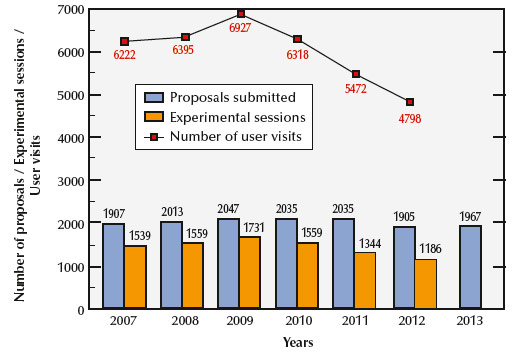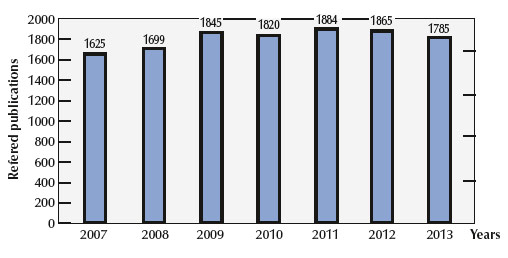User operation
In our 19th year of successful operation for scientific users, we look back on user operation at the facility over the past year, 2013. Following the first ever “long shutdown” from December 2011 to May 2012, 2013 saw the return to full user operation for the majority of users. The new EX2 experimental hall extension was completed and construction work began on the long beamlines which will inhabit this extension building. Phase I of the Upgrade Programme continued its steady course: the new inelastic scattering upgrade beamline ID20 was opened and beamlines ID01, ID02, ID08, ID14-1, ID14-4, ID22 and ID31 were all closed for upgrade at various points during the year to be rebuilt as upgrade beamlines on ID01, ID02, ID32, ID30A-3, ID30B, ID16 (NINA) and ID22 respectively. In total, the equivalent of around 27 ESRF publicly funded beamlines and 9 CRG beamlines were available for users in 2013. Figure 168 shows the number of applications for beamtime received since 2007. The number of applications received is heading back up towards the pre-shutdown level and, taking into account the unavailability of the beamlines undergoing upgrade and the permanent closure of others, the number of proposals received per operating beamline continues to increase.
 |
|
Fig. 168: Applications for beamtime, experimental sessions and user visits, 2007 to 2013. The final number of experimental sessions and user visits for 2013 were not available at the time of going to press. |
Proposals for experiments are selected and beamtime allocations are made through peer review. As in previous years, beamtime for 2013 was allocated based on recommendations made by review committees of specialists, for the most part from European countries and Israel. For 2013 a new structure was put into place for the proposal review process with the aim of allowing all proposals received for a particular beamline to be assessed by the same review committee. This gives the committees a better overall view of all the projects proposed for a single beamline, and allows them greater flexibility to optimise the selection of proposals awarded beamtime on each beamline. Beamlines of similar techniques or activities were grouped together to form 10 new review committees:
- C01 (ID01, ID03, BM25B, BM32)
- C02 (ID11, ID15A, ID15B, ID31)
- C03 (ID08, ID12, ID20, ID26, ID32, BM28)
- C04 (ID24, BM01B, BM08, BM20, BM23, BM25A, BM26A, BM30B)
- C05 (ID06-LVP, ID09A, ID18, ID27, ID28, BM01A)
- C06 (ID17, ID19)
- C07 (ID13, ID16A&B, ID21, ID22)
- C08 (ID02, BM26B)
- C09 (ID09B, ID10, BM02)
- C10 (Structural Biology Beamlines).
 |
|
Table 7: Number of shifts of beamtime requested and allocated for user experiments, in 2013. Note: Methods and Instrumentation figures are for half a year only. |
At the same time, the scientific areas of ESRF research activities were redefined, since these no longer dictate the review committee structure and size. The new scientific areas are shown in Table 7. In addition a societal theme classification was implemented with the aim of monitoring the societal relevance of the research carried out at the ESRF, based on the following themes:
- Earth and Environment
- Health
- Information and Communication
- Technology
- Energy
- Other Functional Materials
- Fundamental Science
- Other
The newly structured review committees met twice during the year, around six weeks after the deadlines for submission of proposals (1 September 2012 and 1 March 2013). They reviewed 1967 applications for beamtime, and selected 845 (43%), which were then scheduled for experiments.
Requests for beamtime in 2013, which is scheduled in shifts of 8 hours, totalled 29,104 shifts or 232,832 hours, of which 12,092 shifts or 96,736 hours (41.6%) were allocated. The distribution of shifts requested and allocated, by scientific area, is shown in Table 7.
 |
|
Fig. 169: Shifts scheduled for experiments, March to July 2013, by scientific area. |
The breakdown of shifts scheduled for experiments by scientific area in the first half of 2013 is shown in Figure 169. This same period saw 2764 visits by scientists to the ESRF under the user programme, to carry out 683 experiments. Overall, the number of users in each experimental team averaged just over 4 persons, as in all previous years, and the average duration of an experimental session was 9 shifts, as in 2012. This can be further broken down to show an average duration of 3 shifts for MX experiments and 13 shifts for non-MX experiments. The annual number of experimental sessions and user visits since 2007 is shown in Figure 168. The effect of the reduction in beamtime available in 2011 and 2012 due to the long shutdown is clearly visible in the lower-than-normal numbers of experimental sessions and user visits. With the return to normal user operation in 2013, we will see these figures rise significantly again once the 2013/II scheduling period finishes at the end of February 2014, although they are not expected to reach pre-shutdown levels due to the lower amount of overall beamtime available.
 |
|
Fig. 170: Numbers of publications appearing in refereed journals reporting on data collected either partially or totally at the ESRF, 2007 to 2013. |
One of the principle measurable output parameters of the ESRF is the number and quality of publications accepted in peer-reviewed journals. Figure 170 shows how this number has been rising continuously over the past years to reach a plateau of just under 1900 publications per year, corresponding to the maximum operation level of the ESRF. These are excellent figures, with a publication output systematically on a level of well over one publication per experimental session. The year 2013 promises to be highly fruitful, with 1785 publications already registered in the ILL/ESRF Library database, though publication levels are expected to drop slightly as a result of the reduced numbers of experiments carried out during 2011 and 2012. Since the ESRF began user operation back in 1994, a total of 23,297 publications have been accepted in peer-reviewed journals. Of these, nearly 300 every year are published in high impact factor journals.
User responses to questionnaires show once again that the ESRF continues to maintain its excellent reputation concerning the assistance and service given by scientists and support staff on beamlines, and travel and administrative arrangements, in addition to the quality both of the beam and of the experimental stations. Facilities on site, such as preparation laboratories, the Guesthouse and a canteen open 7 days a week, also make an important contribution to the quality of user support.



